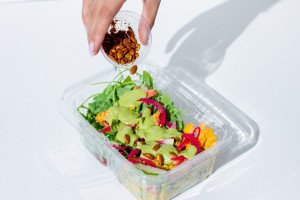Why Your Soy Latte Addiction Could Be Destroying Your Skin
I am probably the soy industry’s leading consumer: Most days, I drink a Starbucks soy chai in the morning, have a quinoa salad with tofu for lunch and eat some veggie sausage with eggs or a tofu stir-fry for dinner. As a vegetarian, soy products are just the easiest, cheapest way for me to fill up. And It had never occurred to me that eating soy, soy and more soy, day in and day out, could have anything to do with my skin problems.
Insert the face-palm emoji here.
Earlier this week, I was chatting with a friend about the curse that is adult acne and she mentioned that she steers clear of soy, mainly because she thinks it messes with her skin. I shouted a bunch of four-letter words in my head then immediately got in contact with Naomi Fenlin, owner of Washington Square West’s About Face Skin Care and renowned fixer of problem skin. Cue to my world being shattered. Turns out, according to Fenlin, soy can screw with your skin in a big way.
“Here’s the story with soy,” Fenlin says, “There is no definitive science one way or the other that proves anything when it comes to your skin and soy. But anecdotally, there is a whole lot of evidence that says it absolutely can impact acne.” Just so you know, at this moment, all the veggie sausage patties I’d ever eaten (hundreds) flashed before my eyes and I might have shed a tear or two.
So why might soy be a contributing factor to the craters on your (and my) face? Well, as Fenlin explains, soy is loaded with isoflavonoids. These bad boys suppress estrogen — or female hormones — in the body, and up the androgen — otherwise known as male hormones — making them more plentiful and powerful. And the overproduction of androgen, Fenlin tells me, is one of the worst culprits when it comes to acne.
But don’t fret, my fellow vegetarians. Soy isn’t all bad: As Fenlin explains, it’s great for stabilizing blood sugar, and it’s also a great source of antioxidants and protein. As she reassures, “As with most things, it just needs to be consumed in moderation. If you’re having it in your coffee and in your cereal and in everything else,” that’s when you might see some problems.
I asked Fenlin what a soy addict should do to determine whether their soy consumption is in fact to blame for their skin problems. Her answer? “Just cut it out of your diet or cut back on your intake significantly. There’s no test, there are no scans, and this is why it’s so difficult to pinpoint from a scientific standpoint — all the evidence is anecdotal. But if you cut it out and your skin clears up, well, you just diagnosed yourself.” Fenlin says to give yourself a month sans soy-filled veggie burgers and your daily soy latte, then reevaluate.
I plan on taking her advice and weeding soy out of my diet for a month to see what happens, so if you’ve got any soy-free vegetarian protein alternatives to suggest, send ‘em my way! And note: If you, too, plan on trying to cut soy out of your diet to get to the bottom of your skin problems, you’re going to have to read a lot of labels. Like sugar, soy is in just about every processed food out there. Godspeed.
Like what you’re reading? Stay in touch with Be Well Philly — here’s how:
- Like Be Well Philly on Facebook
- Follow Be Well Philly on Twitter
- Follow Be Well Philly on Pinterest
- Get the Be Well Philly Newsletter



